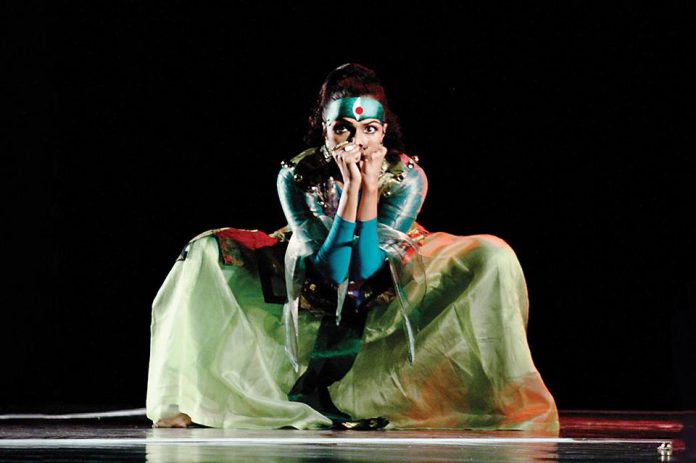It is immediately apparent that costuming will be important to Anita Ratnam’s Melbourne performance of her solo show Ma3Ka (a play on the Sanskrit word Matrika, meaning the trinity of goddesses in the Hindu pantheon). As the artist is revealed on stage, lying on her back in a loose white robe, feet up and crossed gracefully, there is also a coat stand side-stage, hanging with other costumes, promising more.

In the first section of Ma3Ka, the goddess invoked is, ostensibly, Saraswathi, the white-clad goddess of wisdom and music. But the Saraswathi Ratnam speaks about, live, as she moves in loose, abstract motions against staccato sounds of Bharatanatyam jathis and kouthuvam (spoken word poetry), is her grandmother. “I was her shadow.”
From there, this first section becomes autobiographical, as Ratnam speaks emotionally about her grandmother, her mother and her daughter, dancing with slow precision and beauty. However, the narrative here feels clunky, a little trite even, at times. I find my eyes straying frequently to the coat stand waiting at the side of the stage. I want more.
And I get it. Ratnam moves to the coat stand and changes, unexpectedly, into a waist-length orange silk jacket, bangles, earrings and affixes a long false black plait, glittering with gold ornaments, to her bun. Set against piano music, it’s a more grounded version of the neoclassical Indian dance heroine’s ‘dressing’ scene.

Indeed, Ratnam later declares in her artist’s talk that she wants to “not be pretty all the time”, and from this section onwards, I can really see her bold and crucial subversion of this trope of the Indian female dancer.
Ratnam indicates that this section is dedicated to exploring the goddess Lakshmi – goddess of wealth and prosperity – as she sings and translates the well-known South Indian composition, Bhagyada Lakshmi Bharamma.“Welcome, lady of the lotus…what is your true face?” she asks. Placing the red feather she holds in her hair, she uses her braid brilliantly as a fluid prop, using it to sketch out the story of the goddess’s birth from the churning of the ocean. She pulls coins out of the jacket pocket – another deft use of costume and props – and strews it on the ground, marking the more commercial function of the goddess.
And then, in the most daring contemporary feminist spin of the show, she turns goddess worship into a catwalk spectacle. Blasting pop music – including Lady Gaga – as well as Tamil film music, she walks her runway, pouting unashamedly, snapping selfies and rocking poses with sunglasses.
It’s an unabashed embracing of what Ratnam later describes as “goddess glam”. Lakshmi, a goddess that is frequently blasted with the male gaze is here embodied in the model, the film heroine, and the contemporary woman who wants to show off her beauty and her fashion sense.
As Ratnam says in her artist talk, this woman is “deciding she is going to be gazed at”. She is making the choices, she is calling the shots. And she loves it. What is so radical about this is the positivity of Lakshmi’s conflation with contemporary female glamour culture.
For the third section, Ratnam changes into a long caftan that flashes blue and green and red, and ties around her forehead a gold headband reminiscent of female superheroes like Wonderwoman. She invokes Meenakshi, a goddess born on earth as a warrior princess who stands out because of her three breasts. For those familiar with Bharatanatyam, this is a well-worn story and from my perspective, Ratnam needs to create something visually stunning in order to transcend it.
And I’m not disappointed. Ratnam fully embodies Meenakshi as disciplined, intense warrior, using sliding, bending, martial-arts like moves that take the princess’s fighting skills seriously, rather than romanticising them the way Bharatanatyam choreography normally does. Meenakshi’s desire for the god Shiva is also handled beautifully, subverting the cringe-worthy traditional scene where she sees him, goes all shy, loses her third breast, and ultimately all desire for being who she is – a warrior.
Instead, Ratnam maintains the princess’s confident stance, and has her gaze back at Shiva, admiring his beauty, and inviting him to return to her kingdom with her as her consort. She is allowed to be multiple things – sensual, stern, powerful, beautiful – without compromising any one quality.
Ma3Ka feels like an offering of contemporary feminist vision and solidarity within the world of South Asian dance and music, and Ratnam, a sophisticated multi-skilled performer at the height of her powers, feels like the right person to offer it. What the work does most of all, though, is create a gateway to a world of expanding possibilities. Like the coat stand in the corner of the stage, with its eclectic collection of costumes and props, Ratnam’s work tells us that there is more to explore, more to revisit, more to revise, and more to revision.




